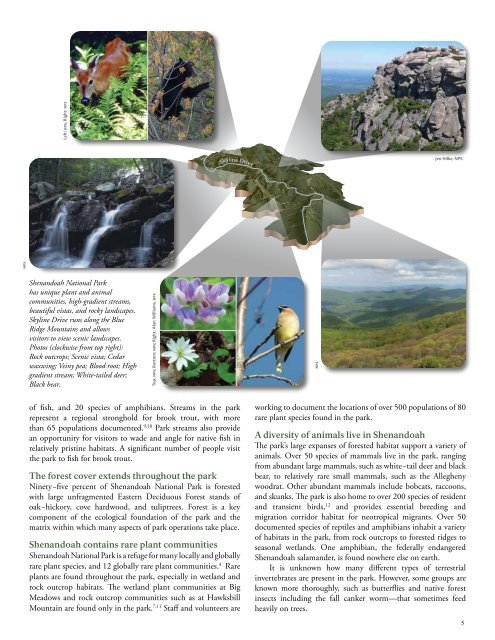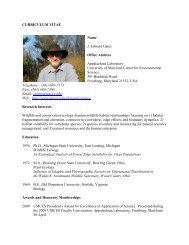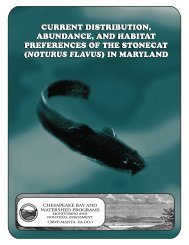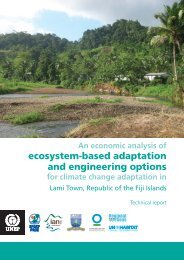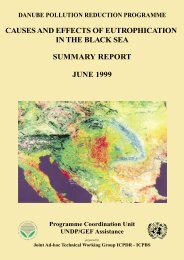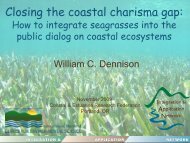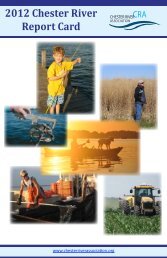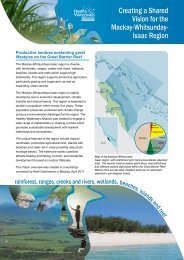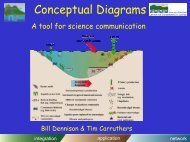Shenandoah National Park - Integration and Application Network
Shenandoah National Park - Integration and Application Network
Shenandoah National Park - Integration and Application Network
- No tags were found...
You also want an ePaper? Increase the reach of your titles
YUMPU automatically turns print PDFs into web optimized ePapers that Google loves.
Left: NPS, Right: npsSkyline DriveJen Hilke, NPSNPS<strong>Shen<strong>and</strong>oah</strong> <strong>National</strong> <strong>Park</strong>has unique plant <strong>and</strong> animalcommunities, high-gradient streams,beautiful vistas, <strong>and</strong> rocky l<strong>and</strong>scapes.Skyline Drive runs along the BlueRidge Mountains <strong>and</strong> allowsvisitors to view scenic l<strong>and</strong>scapes.Photos (clockwise from top right):Rock outcrops; Scenic vista; Cedarwaxwing; Veiny pea; Blood root; Highgradient stream; White-tailed deer;Black bear.Top: NPS; Bottom: nps; Right: Alan Williams, NPSNPSof fish, <strong>and</strong> 20 species of amphibians. Streams in the parkrepresent a regional stronghold for brook trout, with morethan 65 populations documented. 9,10 <strong>Park</strong> streams also providean opportunity for visitors to wade <strong>and</strong> angle for native fish inrelatively pristine habitats. A significant number of people visitthe park to fish for brook trout.The forest cover extends throughout the parkNinety−five percent of <strong>Shen<strong>and</strong>oah</strong> <strong>National</strong> <strong>Park</strong> is forestedwith large unfragmented Eastern Deciduous Forest st<strong>and</strong>s ofoak−hickory, cove hardwood, <strong>and</strong> tuliptrees. Forest is a keycomponent of the ecological foundation of the park <strong>and</strong> thematrix within which many aspects of park operations take place.<strong>Shen<strong>and</strong>oah</strong> contains rare plant communities<strong>Shen<strong>and</strong>oah</strong> <strong>National</strong> <strong>Park</strong> is a refuge for many locally <strong>and</strong> globallyrare plant species, <strong>and</strong> 12 globally rare plant communities. 4 Rareplants are found throughout the park, especially in wetl<strong>and</strong> <strong>and</strong>rock outcrop habitats. The wetl<strong>and</strong> plant communities at BigMeadows <strong>and</strong> rock outcrop communities such as at HawksbillMountain are found only in the park. 7,11 Staff <strong>and</strong> volunteers areworking to document the locations of over 500 populations of 80rare plant species found in the park.A diversity of animals live in <strong>Shen<strong>and</strong>oah</strong>The park’s large expanses of forested habitat support a variety ofanimals. Over 50 species of mammals live in the park, rangingfrom abundant large mammals, such as white−tail deer <strong>and</strong> blackbear, to relatively rare small mammals, such as the Alleghenywoodrat. Other abundant mammals include bobcats, raccoons,<strong>and</strong> skunks. The park is also home to over 200 species of resident<strong>and</strong> transient birds, 12 <strong>and</strong> provides essential breeding <strong>and</strong>migration corridor habitat for neotropical migrants. Over 50documented species of reptiles <strong>and</strong> amphibians inhabit a varietyof habitats in the park, from rock outcrops to forested ridges toseasonal wetl<strong>and</strong>s. One amphibian, the federally endangered<strong>Shen<strong>and</strong>oah</strong> salam<strong>and</strong>er, is found nowhere else on earth.It is unknown how many different types of terrestrialinvertebrates are present in the park. However, some groups areknown more thoroughly, such as butterflies <strong>and</strong> native forestinsects including the fall canker worm—that sometimes feedheavily on trees.5


